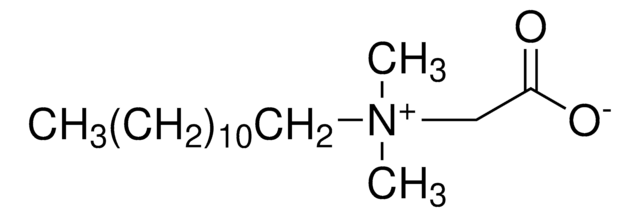H6883
3-(N,N-Dimetilpalmitilamonio)propanosulfonato
≥98% (TLC)
Sinónimos:
3-(N,N-Dimetilhexadecilamonio)propanosulfonato, 3-(Hexadecildimetilamonio)propanosulfonato, 3-(Palmitildimetilamonio)propanosulfonato, Palmitilsulfobetaína, SB3-16
About This Item
Productos recomendados
descripción
zwitterionic
Nivel de calidad
Ensayo
≥98% (TLC)
mol peso
micellar avg mol wt 60,700
número de agregación
155
técnicas
electrophoresis: suitable
mass spectrometry (MS): suitable
thin layer chromatography (TLC): suitable
conductividad
≤10 μmho per cm at 24 °C (0.05 M aqueous solution)
CMC
0.01-0.06 mM (20-25°C)
aplicaciones
cell analysis
cadena SMILES
CCCCCCCCCCCCCCCC[N+](C)(C)CCCS([O-])(=O)=O
InChI
1S/C21H45NO3S/c1-4-5-6-7-8-9-10-11-12-13-14-15-16-17-19-22(2,3)20-18-21-26(23,24)25/h4-21H2,1-3H3
Clave InChI
TUBRCQBRKJXJEA-UHFFFAOYSA-N
¿Está buscando productos similares? Visita Guía de comparación de productos
Categorías relacionadas
Descripción general
Aplicación
Código de clase de almacenamiento
11 - Combustible Solids
Clase de riesgo para el agua (WGK)
WGK 3
Punto de inflamabilidad (°F)
230.0 °F - closed cup
Punto de inflamabilidad (°C)
110 °C - closed cup
Equipo de protección personal
dust mask type N95 (US), Eyeshields, Gloves
Elija entre una de las versiones más recientes:
Certificados de análisis (COA)
¿No ve la versión correcta?
Si necesita una versión concreta, puede buscar un certificado específico por el número de lote.
¿Ya tiene este producto?
Encuentre la documentación para los productos que ha comprado recientemente en la Biblioteca de documentos.
Los clientes también vieron
Nuestro equipo de científicos tiene experiencia en todas las áreas de investigación: Ciencias de la vida, Ciencia de los materiales, Síntesis química, Cromatografía, Analítica y muchas otras.
Póngase en contacto con el Servicio técnico



![[2-(Methacryloyloxy)ethyl]dimethyl-(3-sulfopropyl)ammonium hydroxide 95%](/deepweb/assets/sigmaaldrich/product/structures/217/219/73c91e1c-0ee4-4b3d-bead-a6dc3d09d1da/640/73c91e1c-0ee4-4b3d-bead-a6dc3d09d1da.png)



